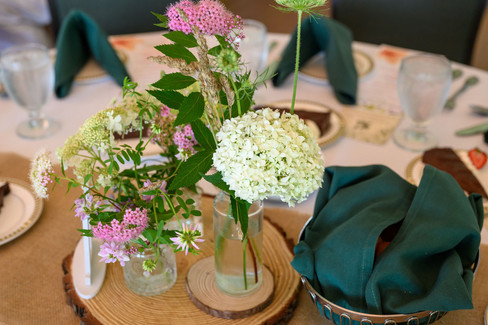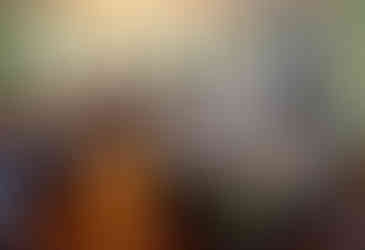
Lightning Bugs
Nothing says summer like a bunch of kids rampaging through the damp fields at night capturing lightning bugs to put into jars. It's so sweet...until it dissolves into conflict and moral outrage once the catching part is over when half the kids want to release the captives and others want to feed and care for them in their jars "forever."
There are questions other than the moral ones: what do you call them—fireflies or lightning bugs? And does it seem like there are fewer lightning bugs out there now? And are our neighbors to blame for killing them with their mosquito spray? Don't they love lightning bugs and summer evenings?
Well, we got some answers this week and I was embarrassed to learn that we have been part of the problem with our tidy mulched yard and neatly raked-up fall leaves.
At our Annual Life Member Lunch last Friday, Holly Shimizu spoke about "Lessons Learned from a Gardening Life." One lesson addressed the mulch vs. leaf litter debate. Without pointing fingers at those of us who may still practice dated methods, she admitted that she and her husband, a landscape architect, have evolved as gardeners and artists in how they weigh the wild and the formal in their own gardens. She told us that they moved away from mulch to leaf litter a few years ago, but were shredding the leaves at first to make it look a little more like proper mulch. Recently they have begun leaving the leaves whole in their garden beds, partly inspired by Doug Tallamy's research into insects and leaf litter. (Note: Doug spoke as part of our Brown Bag lecture series in 2022)
While mulch vs leaf litter seems like an aesthetic question for homeowners—which look do you prefer—for lightning bugs, leaf litter turns out to be a critical habitat. It's where they live during their immature stage and where they forage for food throughout their lives. Sterile mulch is pretty, but, well, sterile.
Our firefly photograph above was by Photographer Anne Day, whose Brown Bag lecture on Tuesday at Smith Wilkes Hall was inspirational. We all left determined to up our iphone photo game, but also having learned that insects are very hard to photograph—even for a professional with a fancy camera. (She recommends a bell jar and the macro setting.) Of course the photo above is more art than insect photo and it was even more striking on the big screen. Anne told us that she had gone out on location to shoot synchronous lightning bugs, but then ended up getting this beautiful shot in her own backyard. Turns out that synchronicity is better captured on video than still frame and it is a really cool phenomenon. Click here to watch a National Geographic video on synchronous lightning bugs.
As we move into fall, I hope you'll join me and consider the future of summer evenings and lightning bugs when you think about exactly how tidy that fall clean-up needs to be. And please read on for more on the lightning bug by BTG Entomologist Dennis McNair.
- Leslie Renjilian, BTG President and Reformed Raker

Monday, July 24 | Location: Meet at Shoreline & Wetland Gardens by the Pier Building |
Tuesday, July 25 | Location: Smith Wilkes Hall 4:15 PM Garden Walk with Horticulturist Joe McMaster Location: Smith Wilkes Hall - Lakeside |
Wednesday July, 26 | 8:00 AM Wednesday Weeding Please join the BTG to help remove invasive plants! Learn more at the link above. Location: Meet at the Butterfly Garden by the South Gate 12:30 - 2:30 PM Open Garden: Shipman Garden at Miller Cottage 4:15 PM Tree Walk with Naturalist Jack Gulvin Location: Smith Wilkes Hall - Lakeside |
Thursday, July 27 | 8:00 AM Bird Walk with Ruth Lundin Location: Smith Wilkes Hall Bring binoculars if you have them, and please leave dogs at home! 12:30 - 2:30 PM Open Garden: Shipman Garden at Miller Cottage |
Friday, July 28 | 9:00 AM Nature Walk with Naturalist Jack Gulvin Location: Smith Wilkes Hall - Lakeside 12:30 PM Garden Walk with Betsy Burgeson Location: Smith Wilkes Hall (front entrance) |
More on Fireflies
by Dennis McNair, PhD
In the part of Pennsylvania where my wife and I spend much of the year, fireflies are plentiful, and strolling near a weedy meadow at dusk on a warm summer evening can reveal a glorious display of flashing by thousands of these spectacular insects. We both grew up in the state of Washington, where there are almost no fireflies, so we first observed this magical spectacle as teenagers while visiting relatives in the Midwest, adding to the exotic experience of being far from home. Now, of course, we are mature and sophisticated, but Chautauqua’s several species of fireflies still cause childlike excitement in us.
Fireflies or lightning bugs are adult members of the beetle family Lampyridae. Unlike many of their beetle (Coleoptera) relatives, their outside wings, called elytra, are soft. (One of my wife’s friends divided insects into “crunchers” and “squishers,” clearly revealing her disdain for them and her chosen method of collection. Fireflies are squishers.) Their immature stages, called glow-worms because they also bioluminesce, live in leaf litter. Both adults and their grubs dine on other invertebrates. Most adults and glow-worms are capable of bioluminescence (producing a cold light) by combining an enzyme (luciferase) with a substrate (luciferin) in the presence of oxygen, magnesium, and the cellular energy source, ATP. The glow-worms seem to startle predators by lighting up at night and they also contain a toxic steroidal chemical, lucibufagin, which predators learn to avoid and might associate with their light production.
The adults can carefully regulate the emission of a yellow-green or reddish light (occasionally appearing blue from a distance) from the underside of their two last abdominal segments. The adult females typically flash their light signals in a species-specific pattern from a perch and evoke a flash in response from the males of the same species while the males are flying (for example, the males of the Pennsylvania firefly, Photuris pensylvanica, repeatedly produce a “dot-dash” flash pattern that lasts briefly while they fly).
Females of several species of the common genus Photuris are called femmes fatales because they are capable of luring males of other species by mimicking that species’ flash patterns. Once they have lured the unsuspecting males to them, they then capture and eat them, thus concentrating the lucibufagin that the males carry and making themselves, and probably their eggs, less likely to be consumed by other insectivorous animals. In fact, researchers have shown that females will actually fly to flashing males and capture them in flight. (The carnivorous habits of fireflies lead to a common consequence for children who collect several fireflies in a glass jar, place the captured, flashing insects on their nightstands in their darkened bedroom, and awaken the next morning to a jar containing only one, well-fed female and a few inedible insect parts.)
We might all lose this source of night-time enchantment, however. Our habit of leaving lights on at night obscures the flash patterns and makes it difficult for fireflies to find mates. Raking up leaf litter removes the habitat of prey items for both adults and glow-worms. As with so many human activities aimed at making our world appear neater or more uniform, we make our surroundings less hospitable for the biodiversity that has evolved into an intricate ecological web surrounding and supporting our continued existence. And wouldn’t it be sad if children (and adults) lost this source of night-time delight and wonder from their lives. As with far too many biological processes, our well-intentioned activities have made our world less rich and beautiful. In the words of Walt Kelly’s wise little opossum from the comic strip Pogo on the first Earth Day in 1970, “We have met the enemy and he is us!”
Much more information on these fascinating (and dwindling) insects can be found in Lynn Frierson Faust’s 2017 book Fireflies, Glow-worms and Lightning Bugs (Univ of Georgia Press).
- Dennis McNair PhD
Outside The Gates


Wild America Nature Festival
Panama Rocks
July 29 & 30
10:00 AM - 5:00 PM
On July 29th and 30th, the 4th annual Wild America Nature Festival returns to Panama Rocks! The festival features artists and other crafts, food and farmer's market, live animal presentations, music, and other activities. Some of the BTG's repeat guides, Jonathan Townsend and Twan Leenders, will be speaking at the festival. One-day admission for ages 13+ is $12. You can learn more on the festival's website.
The BTG encourages all to take the opportunity to attend the largest, FREE, self-guided Garden Walk in America, Garden Walk Buffalo, on Saturday, July 29 and Sunday, July 30, 10:00 - 4:00 each day (rain or shine).
Over 300 gardens will be open throughout the City of Buffalo - some grand, some modest - but all beautiful!
You are totally on your own to travel to Buffalo and decide which neighborhoods you’ll visit. We will have Garden Walk Buffalo maps (and a few suggestions) available to help you plan your tour at this week's Brown Bag Lecture - Tuesday 12:15pm at Smith Wilkes Hall. Please find BTG Board Member Susy Warren at the Membership Table - she's our expert!

Workshop: Painting Birds with Watercolor
Roger Tory Peterson Institute
July 30th & August 6th
1:00 - 2:30 PM
(From the RTPI website) This workshop is back by popular demand and will be held over three consecutive Sundays, July 23rd, July 30th, and August 6th, from 1-2:30 each day. In these classes, you will learn how to paint realistic and lifelike birds. We will go over the fundamentals of watercolor painting, with a strong focus on drawing. This workshop will cover color theory, composition, the different ways to use watercolor, and will give you the skills to begin confidently painting birds (and other wildlife) using watercolor paint. We will begin using quick sketches to create gesture and movement, and will be utilizing thumbnails, studies, and practice paintings in order to problem solve. Students are encouraged to bring in their own bird references and photographs to create their own original bird painting. – Roger Tory Peterson Institute
Art After 5 featuring Kody & Herren
Roger Tory Peterson Institute
July 28
5:30 - 7:30 PM
Tickets $16-18
Attend Art After 5 at the RTPI to hear live music by Kody & Herren and have full access to the museum, drinks from the RTPI bar, and charcuterie. The current exhibition at the RTPI is Art that Matters to the Planet: Interconnectivity. You can learn more and buy tickets here.
Catch Up With The BTG
Jonathan Townsend's Bat Chat on Sunday night was our most well-attended event of the season with 215 people turning out to hear about his research and to hear the sounds our little friends make as they zoom around after dark.
Post-bat chat, we thought it'd be appropriate to keep everyone reading and thinking about bats! BTG board member Nick Stupiansky shared this website:
Above: more photos from Jonathan Townsend's Lake Walk in week 3 on Edible Plants.

Thursday was Jack Gulvin's last Purple Martin Chat of the season. The young have mostly fledged and will be leaving Chautauqua to meet up at their pre-migration roosting site on Lake Erie before the migration to Brazil.
More photos from our Life Member Luncheon! New members gather on the porch. Leslie Renjilian announces that Betsy Burgeson has been awarded the President's Award. Holly Shimizu speaks to the BTG Life Members in the Parlor of the Athenaeum Hotel. Beautiful centerpieces created by Hospitality Committee co-chairs Lynette Caplice and Cathy Clark.
A monarch landed in the polinator garden as if on command during Betsy Burgeson's Monday's Lake Walk.


Drew Farrell and Betsy Burgeson at the Welcome Table at the Main Gate on Chautauqua County Day Thursday. Betsy and Jack led tours for about 30 county residents.
And finally, some photos from this past week's Bird Walk and Garden Walk.
Read About Us

Need help finding your way? Take a peek at our beautiful map drawn by Jane Nelson, or use the interactive version in the BTG app, to locate all of the gardens on Chautauqua Institution!





























Commenti